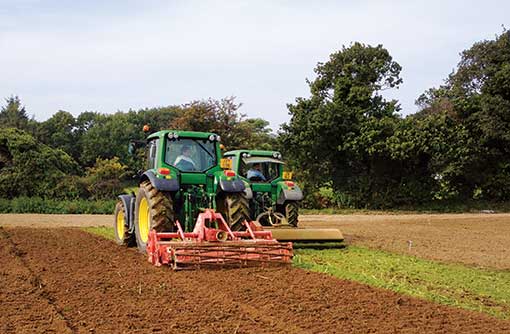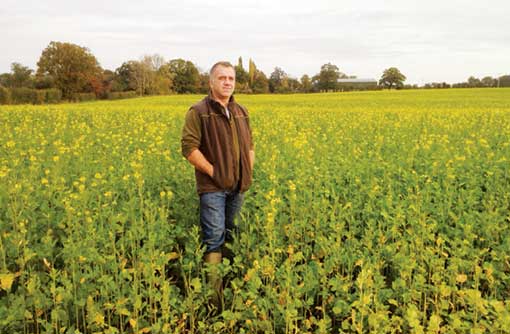Cover crops to control potato cyst nematodes

New research is showing some practical tips for countering the biggest pest threat to the potato crop without using pesticides. Adam Clarke reports from the fields of Shropshire
Incorporating cover crops can give good non-chemical control of the potato crop’s most serious pest with 60-85% reduction seen in potato cyst nematodes (PCNs).
Research focused on growing a number of brassica species ahead of potato planting has shown a reduction in PCN numbers.
Brassica cover crops such as Indian mustard, when macerated and ploughed in, decompose and produce a biofumigation effect.
Those used to produce this biofumigation effect have been selected for their high levels of glucosinolates. When combined with a certain enzyme and water in the soil, glucosinolates produce substances toxic to nematodes known as isothiocyanates (ITCs).
Work at Harper Adams University – in conjunction with Agrovista and Barworth Agriculture – has worked on which brassica species give the best level of ITCs for PCN suppression.
“Brassicas usually contain six or more glucosinolates that produce a range of ITCs and modern biofumigation crops are bred for the highest levels possible,” says Matthew Back, the university’s PCN expert.
Dr Back and his team focused on Indian mustard and also oil radish, white mustard and rocket, all brassica species that contain high levels of glucosinolates.
“Plants are naturally high in glucosinolates, but they are completely inert until cells are damaged, when they combine with the enzyme myrosinase in the presence of moisture to produce volatile substances called isothiocyanates,” he explains.
“It looks like we need to focus our attention on summer-established Indian mustard and oil radish for PCN control.”
Matthew Back, Harper Adams University
It is that substance that provides the biocide effect that suppresses PCN, but can also control potato skin blemishes such as rhizoctonia and black dot, which reduce tuber quality and saleable yield.
The project research shows that the Indian mustard has displayed the greatest efficacy against PCN, with its high proportion of the most potent glucosinolate – sinigrin.
Dr Back says this may not be suited to all situations as the mustards are susceptible to clubroot and verticillium wilt, so may be more of a hindrance in close rotations of oilseed rape or other brassica crops.
“Radish thrives in the summer, but also tolerates overwintering and isn’t susceptible to clubroot, so could be the better option in those situations,” he says.
He also points out that white mustard contains more of the enzyme myrosinase, so has the potential to be used in mixtures to increase the enzyme activity when crops are incorporated.
Rocket has shown that it has winter hardiness, but is the least effective for PCN control and has moved further down the pecking order when considering a cover crop mix.
“It looks like we need to focus our attention on summer-established Indian mustard and oil radish for PCN control,” says Dr Back.
But perhaps the most exciting discovery from the project, conducted by PhD student Bruno Ngala, was evidence that the viability of nematode eggs within the characteristic cysts that lay dormant in the soil is decreased without the maceration and incorporation.
Dr Back explains that glucosinalates can be leached from roots, but the enzyme myrosinase cannot, and his theory is that micro-organisms in the soil are producing myrosinase to use glucosinolates as a food source.
Although only a theory, it could mean that growers could get a level of control from merely growing the crop.
“Our own work has thrown up some good results, but we need to take it forward and further new projects looking into biofumigation have begun this year to reflect that,” says Dr Back.
A three-year project, funded by the Potato Council, will investigate the suitability of species around Great Britain, incorporation methods and cover crop nutrition.
The Potato Council research and development manager Sue Cowgill says that the trials will take place in Shropshire, eastern England and Scotland.
“We need to understand which cover crops perform best in which region and how their performance is influenced by crop agronomy and incorporation techniques,” she says.
Additional, more fundamental work funded by the horticulture and potato initiative (HAPI) will kick off in the new year, looking into the impact of those factors on glucosinalates and other chemicals that the cover crops produce.
Distributor and adviser Frontier is also investigating incorporation efficiency.
“It is no silver bullet for PCN control and there are still questions to be answered, but it’s certainly going to give us a benefit as part of an integrated strategy,” adds Dr Back.

An integrated approach for sustainable production
For one Shropshire grower it was either get on top of the farm’s nematode population, or park up the potato kit for good and cover crops have helped slash PCN levels.
Neil Furniss of M E Furniss and Sons, based in Caynton, near Newport, grows about 50ha of Marfona and Maris Piper potatoes for the pre-pack market on his 410ha of sandy loam soils, so skin finish is paramount.
The farm has been growing potatoes for 40 years and as PCN populations have built up, yield and quality was being compromised from nematode feeding.
“It reached the stage in 2003 when we had to do something about it or the farm would cease to grow the crop,” says Mr Furniss.
The farm has invested heavily in expensive chemical fumigation with Telone (1,3-dichloropropene) before it was banned and now metam-sodium, which is carried out by specialist contractors.
Mr Furniss also uses broadcast and incorporated applications of Vydate (oxamyl) ahead of planting to ensure that there isn’t any multiplication in the nematode population after fumigation.
Having moved from a one-in-four to a one-in-six rotation, the farm has also been using biofumigation cover crops for four years, with advice of local specialist PCN agronomist Andrew Wade.
“PCN has needed an integrated management approach on our farm using nematicides, biofumigants and volunteer management throughout the rotation,” says Mr Furniss.
The cover crop mix is broadcast in July after winter barley behind a Gregoire Besson Discordon and rolled, followed by an application of pig slurry from the farm’s pig unit.
The crop is then flailed, rotovated and ploughed all within an hour to ensure maximum efficacy and Mr Furniss prefers to do it at mid- to late-flowering, which is normally early November.
“I don’t want to make a mess if it’s too wet, so we would wait until the spring if conditions turned against us.”
Mr Wade blends the seed mix, which includes 5kg/ha of Caliente 199 mustard and 10kg/ha of Bento fodder radish, both of which suppress nematodes in the soil.
“Both are good for fumigation, with the Caliente strong on PCN and the radish giving some extra benefit on free living nematode (FLN) control too,” he says.
In addition to nematode suppression, Mr Furniss is also seeing great benefits for soil quality and nutrition from the “green manure” effect.
“The crop is sucking up nitrogen in the autumn and that is being released in the following spring for the potatoes to utilise and we have seen visual differences in the crop,” explains Mr Furniss.
Unconventional way to smash growers’ biggest pest threat
Potato cyst nematode (PCN) is the potato growers’ biggest pest threat, costing the UK industry in excess of £50m annually.
A dwindling conventional chemistry set and lack of resistant varieties is only making control of this pest more challenging.
With PCN present on two-thirds of potato growing land in the UK, Dr Back says reliable control alternatives need to be sought.
“It’s very unlikely that conventional fumigant metam-sodium will be re-registered when it’s reviewed after 2014.
“In addition, the hazardous nature of the two nematicide options Nemathorin (fosthiazate) and Vydate (oxamyl) leaves a big question mark over those products too,” he explains.
With limited chemistry to control the two major species of PCN, Globadera pallida and Globadera rostochiensis, resistant varieties would offer a useful tool.
There are varieties that offer full resistance to G rostochiensis, which stops the multiplication of nematode populations within the soil.
However, there is only partial resistance to the more widespread and aggressive G pallida.
On a global scale, biofumigation by incorporating cover crops attracted interest when the fumigant methyl bromide was banned in the wake of the 1987 Montreal Protocol – designed to protect the ozone from further damage.
But much of the early research and advice on using cover crops to control soil pathogens came from North America, Australia and Italy and was not relevant to UK conditions.
“Seed companies came over making claims about these crops and when they didn’t work here, the UK industry lost confidence,” says Dr Back.
“We need to cut through the snake oil and produce some advice for potato growers on how to make them work for PCN control in our climate and rotations.”
- Biofumigation will be one of the topics up for discussion at Potato Council’s BP2013 industry event on 27-28 November in Harrogate, Yorkshire, where growers can discuss the results of the latest research with their R&D experts.
Go to www.bp2013.net.
- In 2014 the fifth International Biofumigation Symposium will be held at Harper Adams University on 9-12 September where growers can get further advice on what biofumigation crops can do for them. For more information visit www.harper-adams.ac.uk.
Read more news and information for potato growers

